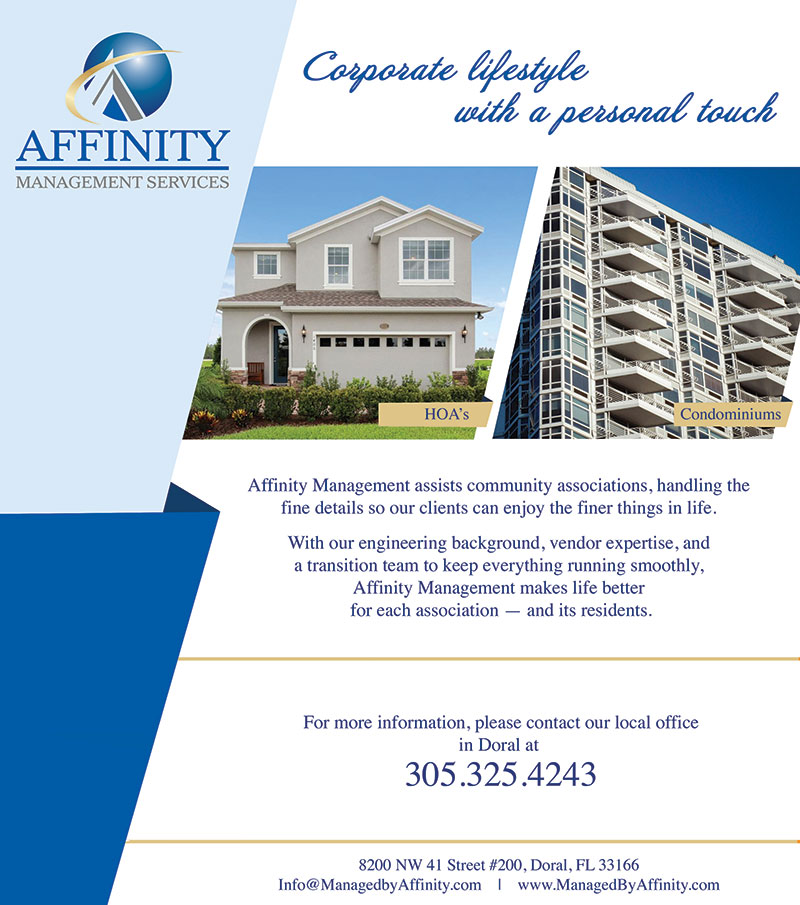Community Association Budgeting Made Easy, by Affinity Management Services
By: Pedro M. Garcia, CAM, CMCA, AMS – Affinity Management Services
An Association’s annual budget assists the Board of Directors by projecting expenses and creating a benchmark. The annual budget is an estimate of all revenues, expenses, and reserves for operating and reserve fund management deferred maintenance and capital expenditure projects. The annual budget also provides an estimate of the funds needed to cover recurring expenses for day-to-day operations and long-term expenses. Preparing the annual budget for your community association can be stressful—but it doesn’t have to be. Think of it as an opportunity to reassess your community’s financial goals and put an effective plan into action.
The Budget is a Map to your Association’s Financial Success
Simply put, the budget is a map that will help guide the Board of Directors in making financial decisions during the course of the year. If your Association’s fiscal year follows the calendar year, the best time to begin the process is in August. Getting an early start ensures that:
- A proper financial analysis is performed. In this case, the financial information used should consist of actual income and expenses.
- All insurance, service vendors are contacted to establish a reasonable projection of increases and renegotiation of services and pricing
- All parties have had an opportunity to provide their suggestions. Clear expectations will avoid arguments about what it is that the Association should be paying for.
Do you want to be a part of your budget committee?
Ideally, the budget committee is comprised of members of the Association. That way, residents can have a say in how their money is spent. Another bonus would be if any members have expertise in such areas as insurance, maintenance, and contract services. Their insights will prove to be invaluable.
The Board Treasurer typically chairs the budget committee. As chair, it is the Treasurer’s duty to keep everyone on track as the budget is prepared. The Treasurer also presents the budget for approval to the Board and the members. If a committee cannot be organized, the Treasurer should still take leadership on the budgeting process and work closely with Management to conduct the necessary research, analysis, and preparation to present the budget.
The Basics
The main elements of a budget are operating expenses and reserve contributions. Funds needed for daily operation of the community are either contractual or can be reasonably estimated based on historical analysis. These can be broadly categorized as:
- General & Administrative: Management Services, Professional/Legal Services, Insurance, and Office Supplies
- Utilities: Gas, Electric, Telecommunications, and Water & Sewer
- Maintenance: General, HVAC, Plumbing, and Electrical
- Contracted: Janitorial, Security, Landscaping, Extermination, and Trash Removal
In respect to hurricane season, the Association should also consider budgeting an appropriate amount towards a contingency fund that will help deal with pre-storm preparation, post-storm recovery, and insurance deductible payments. Industry guidance dictates an amount up to 5% of your annual budget, not including reserves.
Does your association have reserves?
Reserves are monies set aside for specific expenditures that will be incurred in the future. Usually, such expenditures relate to the cost of major repairs to, or replacements of, the Association property such as such as roof, pool, asphalt, elevators, paint, and life safety systems. If funds are not set aside for these expenses, unit owners will usually have to pay a special assessment at the time such repair or replacement occurs. Florida statute requires that reserve allocations be made for roofing, painting, paving, and any other items for which the deferred maintenance expense or replacement cost exceeds $10,000.
The preparation of a reserve schedule is a task of significant importance requiring expertise and resources that will allow for the proper evaluation and inventory of all common elements and components requiring reserve allocation, determination of its total useful life, remaining useful life, and cost of deferred maintenance or replacement. There are specialized professionals such as engineers, contractors, and Reserves Specialists that can provide the Association a reserve study report which will meet the Association’s needs when planning for reserves. It is strongly suggested that the Association acquires a reserve study and properly funds for reserves.
If the Board of Directors wishes to adopt an annual budget without reserves, it must understand that waiving or reducing reserves requires a vote of the unit owners. Adopting an annual budget without reserves that do not follow the required ownership vote places the Association in a serious compliance risk with Florida state requirements.
A final consideration of the budgeting process is the Association’s liquidity position. This takes on a different perspective than simply looking at income and expenses. When considering liquidity, the Association is defining its ability to meet all current liabilities with its current assets. The routine items that usually fall in this category are:
- Current Assets: Operating Cash, Accounts Receivable Minus Allowance For Bad Debt
- Current Liabilities: Accounts Payable, Accrued Expenses, Prepaid Owner Payments
When the analysis conducted by subtracting Current Liabilities from Current Assets, that amount is considered the Association’s working capital. Industry guidance dictates that an Association should have at a minimum two month’s operating funds at the end of every monthly operating cycle.
Budget with a Team
Preparing an annual budget is truly a team effort requiring multiple perspectives and the gathering of a lot of information. At Affinity Management Services, the budgeting process has been streamlined to provide the Board a preliminary draft budget accompanied with supporting analysis, financial statements, respective vendor estimates, and proposals, and if needed, expense ledger histories. Aside from reducing the amount of time needed for the board to review and understand what is being proposed, this system expedites the most important portion of the budgeting process—the thoughtful and progressive discussion.
We focus on assisting the Board of Directors in the preparation and presentation of the annual budget by facilitating relevant information in an easy to understand manner. Moreover, we place a great deal of emphasis on making our proposed draft to the Board of Directors something that reflects our honest and professional projections that will adequately fund the Association’s needs.
Now that Affinity Management has moved into the Doral community, we invite you to consult with us for your associations’ needs. With our engineering background, vendor expertise, and a transition team to keep everything running smoothly, Affinity makes life better for each association—and its residents. One of the ways our team can assist the associations in this community is by providing our expertise on budgeting.
For more details on how our team can assist your community, or request our budget guide, contact Ashley Artiles at AA@ManagedByAffinity.com.


